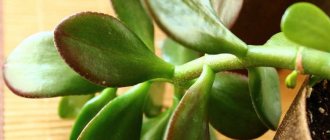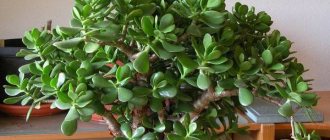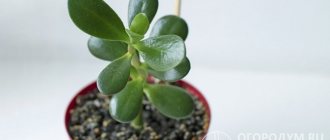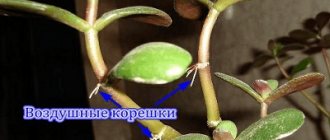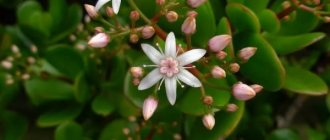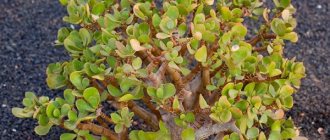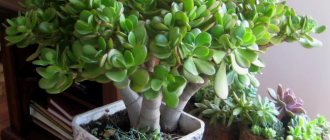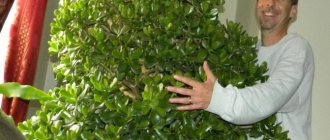Conditions for keeping a money tree at home
Crassula is an unpretentious plant. It easily tolerates lack of moisture and open sunlight. One of its names - Crassula - indicates the ability to accumulate moisture in thick and fleshy leaves. In the absence of watering, Crassula can survive a dry period using its own reserves, consuming water from the foliage.
The extensive Tolstyankov genus includes more than 300 species. Among them are small plants (several centimeters high) and giant ones - up to several meters tall.
This is how Crassula grows with proper care
Table: necessary conditions for the development of Crassula
| Criterion | Spring-summer period | Autumn-winter period |
| Lighting | The money tree prefers a well-lit southern, eastern or southeastern window sill | During the dormant period, from November to March, the pot with Crassula should be placed in a less lit place, for example, on a northern windowsill |
| Air temperature | The ideal temperature range is from 20 to 30 °C. The plant tolerates higher temperatures quite well, but then it requires shading. | The ideal temperature range is from 10 to 16 °C. Critical indicator: -5 degrees |
| Air humidity | After the midday heat, you can spray the leaves to refresh the plant. | Periodically (at least once a week) wipe the leaves from dust |
| Watering | Liberally once or twice a week | Once to three times a month |
The flower signals a lack of moisture with soft leaves. The water should be lukewarm or at room temperature; the best time for watering is in the evening.
Important to remember:
- For proper formation of the bush, the money tree should not be placed close to a window or wall. To ensure that the crown has a symmetrical shape, the fat plant is rotated around its axis from time to time, then the lighting will be evenly distributed to all sides of the plant;
- air humidity is not important for Crassula (the plant is native to the southern regions);
- Crassula copes with a lack of water better than with its excess.
Crassulas have been grown in indoor floriculture for more than three hundred years, since they were brought to Europe by sailors from the African continent.
A healthy money tree needs fertilization. Often this is not required; it is enough to feed the plant once a month with mineral mixtures for succulents.
Video: mistakes when caring for a money tree
Crown modeling
The money tree has an interesting structure, which allows the owner to model its crown to his taste. If you do not control the growth of branches, the tree can become lopsided, stretch out, and acquire an ugly appearance. Forming a crown is not a difficult task: it is enough to remove an unnecessary shoot in time or, conversely, stimulate the growth of an additional branch. To create a new branch, the two apical leaves are pinched. Soon additional stems will appear in this place.
The crown of the money tree can be shaped as you wish
There is no need to rush to remove excess leaves from the trunk of the money tree. As the crown grows, they will disappear on their own, leaving the trunk with a natural appearance.
Video: correct formation of the Crassula crown
The main mistakes in the process of tree transplantation
Beginning gardeners often make mistakes when replanting, which can lead to the death of the plant. These include:
- frequent change of environment;
- selection of large capacity;
- acidic or alkaline soil;
- presence of drafts or direct sunlight.
These errors can lead to the fact that the plant will not be able to adapt after transplantation and will die. The fat plant experiences stress when changing its habitat. Conditions are being created for her to recover.
Caring for a money tree is easy. If you follow simple rules, you can grow a magnificent plant that will decorate your apartment.
Boarding and transfer times
The most favorable time for planting or replanting indoor plants is considered to be early spring, when a new life cycle begins, the plant is ready for renewal and tolerates a change of residence well. The money tree is no exception in this sense.
Crassula also copes well with autumn replanting, although it is undesirable. A good reason for replanting in the fall is plant disease or the appearance of pests. To save the plant, replanting is recommended at any time of the year, even in winter.
How often to replant Crassula
The fat woman does not approve of frequent transplants; this is extremely stressful for her. A young plant (up to two or three years old) should be transplanted into a new pot once a year. An adult tree grows more slowly, so it is enough to provide it with a larger pot once every three to four years.
How to replant according to Feng Shui?
Before planting, place a few pebbles in the bottom of the pot for drainage and a coin on top with the obverse. Next, pour soil into the pot and place the Money Tree itself.
In this process, you need to talk about a conspiracy three times, the essence of which boils down to increasing wealth. His words can be anything, the main thing is the energy when pronouncing them. You need to invest everything in them to become richer and imagine yourself as a successful person. The effectiveness of the talisman also depends on the strength of emotions.
How to make a talisman from a plant?
Any talisman feeds on the energy of the owner, so the effectiveness of the amulet depends entirely on the person.
And capital flows are characterized by complex energy that requires a respectful attitude, so they are more supportive of those serious and responsible people who know how to manage money wisely. To consolidate the efficiency of the energy flow with the tree, the following manipulations should be carried out:
- decorate the trunk with red ribbon;
- place a red napkin under the pot, preferably with money characters;
- place a banknote or three coins under the napkin;
- put some shiny coins in the pot, which need to be cleaned regularly.
The money tree not only needs to be fed with the right energy, but also the usual care measures must be followed to keep the plant alive.
As for coins, there are these rules:
- don't put too much;
- to enhance the effect, you should choose the largest denomination;
- if you want to earn income in the currencies of other countries, you should use foreign coins.
You can also place three Chinese coins with red ribbons on a grown and strengthened tree. And on New Year's Eve, as the most energetically powerful day, you can decorate the branches with additional coins. However, they don't have to be real; chocolate will work too. The main thing is a bright sparkling wrapper.
Where to put the flower?
It is necessary to place the Money Tree in the southeast of the house, because this place is considered the secret of material wealth. Thus, the plants will be able to fully demonstrate their magical properties. However, in order not to disturb them, you cannot place water nearby, because the energy of the tree will not only weaken, but will also impede the movement of cash flow.
Around Crassula you can place a full-fledged money corner. To do this, you can place objects with the following characteristics next to it:
- made of wood, paper or cardboard;
- rectangular or cylindrical;
- red, green or purple.
Since the tree is a succulent, it should be placed in a sunny location. This could be a window sill or a flower stand by the window.
What kind of soil and pot are needed?
The money tree is unpretentious to the composition of the soil and the size of the pot. But he still has his preferences.
Suitable soil
Even a novice gardener can make good soil for a money tree. To prepare your own substrate you will need:
- fresh humus;
- calcined sand;
- leaf soil;
- turf land.
The first three components are taken in equal proportions. But three times more turf land will be needed. The soil should be loose, well permeable to water and air. It is better to maintain soil acidity levels at a neutral value, somewhere in the range of pH 6.5–7.0.
If you don’t want to bother preparing the soil yourself, you can use a purchased mixture. Any universal soil is suitable for a money tree. Ideally, a special substrate for succulents. It is advisable to add sand to the universal mixture (in a ratio of one to four).
Crassula requires good drainage. For young plants, a two-centimeter layer of broken brick, river pebbles or expanded clay is sufficient; for more powerful specimens, the drainage layer increases to 5–10 cm. The top layer of soil must be covered with mulch. It will prevent rapid drying out and give a decorative look to the pot. For this purpose, you can use pebbles, crushed stone, tree bark and chips, nut shells, dried autumn leaves, straw, and processed glass.
Selecting the shape and size of a new pot
The root system of the money tree is located close to the surface of the earth. That is why you need to select wide and shallow pots for it. The diameter of the dishes is determined by the diameter of the crown: the dishes should be slightly wider than the crown. This is necessary for the stability of the plant so that it does not inadvertently turn over.
Shallow, stable containers are ideal containers for Crassula
To highlight the beauty of Crassula, it is better to take a ceramic pot. You can, of course, plant the crassula in an ordinary plastic vessel, but the plant will lose a lot in aesthetic perception. Brown or terracotta-colored dishes go well with the fleshy leaves of the money tree. Feng Shui teachings recommend decorating a pot with coins to attract cash flow. Coins can also be placed in the drainage layer.
Soil selection
The soil mixture plays an important role when planting. It must be loose enough so that the Crassula root system receives a certain amount of oxygen. You can buy ready-made soil at a specialty store or mix the soil yourself. When choosing ready-made soil, you should give preference to a substrate intended for succulents. Before purchasing, carefully study the composition of the soil substrate. It should not contain peat, which increases the acidity of the soil. And the soil for Crassula should be low acidic.
In addition to the main soil for Crassula, you need to take care of the drainage layer. It is drainage that prevents water from remaining in the soil. Without drainage, water will stagnate, leading to root rot of the plant. Crushed stone, brick chips, and gravel can be used as drainage. Shredded polystyrene foam is also suitable, which can protect the soil from freezing.
You can make your own soil mixture for a money tree. The substrate must include the following components:
- turf land;
- deciduous soil;
- humus (small amount);
- sand (must be river and coarse-grained);
- wood ash.
When making your own soil substrate, it is important to treat the soil before placing it in a container. For processing, you need to pour raw sand into a metal container. Spread the base soil on top in an even layer. The container with the soil substrate should be covered with foil and placed in the oven. The soil should be “bake” for 40–50 minutes at a temperature of 80–100 °C. After frying, it is necessary to give the soil substrate time to cool, and only then can it be placed in a pot.
Methods of propagating a money tree: what exactly to plant
An unpretentious money tree can be propagated in three ways:
- propagation by cuttings;
- leaf rooting;
- sowing with seeds (very rarely used).
The simplest method is cuttings. 8–10 cm shoot tips are suitable for this purpose. The cut of the branch is dried for two days, after which the cutting can be rooted. There are two ways:
- rooting in the substrate;
- obtaining roots in water.
Rooting cuttings in the ground
The cut of the cutting must be treated with crushed coal. You need to take a small pot, but such that the money tree cuttings can live in it at least until spring. For rooting, you will need a light mixture of river sand and garden soil.
Greenhouse conditions are favorable for rooting of Crassula cuttings
Place the shoot in a depression (made, for example, with a pencil), sprinkle it with earth, water it and cover it with film or a plastic cup. You can water the plant without removing the cup. The creation of a greenhouse effect has a beneficial effect on the rooting of the shoot. As soon as a new leaf appears on the cutting, you can remove the cover - the money tree has taken root and started growing.
Growing roots in water
This path is even simpler. On a cut money tree branch, the lower leaves are removed, leaving a couple or two. The cutting is placed vertically in a glass half filled with water with the drug Kornevin added to stimulate root growth. Place the container in a shaded place for two to three weeks. Usually during this time the roots appear - the plant is ready to be planted in the ground.
The cuttings of the Crassula are placed in a glass of water until roots appear.
Growing a new plant from one leaf
Growing a money tree from a single leaf is very similar to rooting a cutting. The cut of the leaf must also be dried and then placed in loose soil. To prevent the leaf from falling, it will need supports made of matches or toothpicks. Creating greenhouse conditions and regular moistening promote leaf rooting. The opportunity to grow a money tree from a single leaf is quite real and achievable.
You can grow a money tree from one leaf
Sow Crassula seeds
Seeds are sown in low containers filled with a mixture of sand and leaf soil, and covered with film or glass to maintain high humidity. To prevent blackleg, the soil is spilled with a solution of Fitosporin.
What to consider when choosing a pot for Crassula?
The main condition when choosing a pot is large width and shallow depth. The further growth of the plant and its attractiveness depend on how correctly the container is chosen.
Size and volume
Stability is important for the money tree.
It has an extremely heavy crown - made of an abundance of thick, succulent leaves. And if the pot is chosen incorrectly—too big or light—it may tip over. What to consider when choosing the size of the pot:
- The diameter of the pot should correspond to the size of the crown. Do not need anymore. But this rule is valid for plants under 2 years old. If the fat plant is older, branched and voluminous, you can take a pot a couple of centimeters larger than the crown.
- Transplanting a grown Crassula into a new pot. Take one so that its diameter is 2-4 cm larger than the previous one. Plant cuttings in small pots with a diameter of 5-7 cm. When transplanting young plants, increase the diameter of the pot by 1-2 cm.
- Selecting the depth of the container. Choose it so that another 2-3 cm of fresh soil fits between the roots and the drainage layer. The container should be such that the roots of the plant fit freely in it.
- Choosing a pot for an adult plant. Choose it so that it can accommodate drainage - about a quarter of the volume, the root system, and still have 2-3 cm left on top and on the sides - for fresh soil. This is how you choose a pot when planting in soil or peat.
- If an adult Crassula is planted in a mineral gravel substrate. You can take a vessel of any size. The main thing is to consider what it will be filled with: expanded clay and pumice - they are light, the flowerpot can easily turn over;
- gravel is heavy, difficult to move the container;
- Lechuza Pon is too expensive to spend a lot.
A pot that is too small interferes with the growth and development of Crassula, but one that is too large is no better - the excess soil will turn sour, the roots will rot and the succulent will die.
Variety and form
If the pot is filled with a substrate containing organic matter, it is better to use a regular pot - a container with a ratio of circumference to height of 1.25:1. The bottom of classic pots should be smaller in diameter than the upper circle.
Tips for choosing the shape of pots:
- Containers can be round or in the form of a truncated pyramid.
- It is allowed to grow Crassula in narrow pots, but in this case the drainage should not occupy a quarter of the pot, but more than half.
- Vessels in the shape of bowls are not suitable when using peat and soil substrates - in small bowls there is practically no space left for drainage, in large bowls the soil becomes sour.
- Containers of unusual shape are only suitable for planting Crassula in the substrate; in such pots a drainage layer is not needed, there is sufficient aeration even without it, the shape is chosen taking into account aesthetics: Bowls with low edges. Used when planting several crassulas at once, for bonsai trees, creeping and hanging plants, compositional solutions from succulents.
- Long and narrow containers. Choose for single plants. You can also add sedum or ground cover.
- Flowerpot.This decorative dish does not have a hole at the bottom. Usually unattractive or cheap pots are placed inside the container. You can put moss between the pot and the flowerpot - it will collect excess moisture when watering. The planter also gives the pot extra stability.
Material
Most often, money trees are grown in clay or ceramic pots. They are heavy and stable enough not to tip over under the weight of the crown. At the same time, products made of ceramics and clay always look beautiful, they fit harmoniously into any interior.
Suitable materials for pots:
- Transport plastic. It is convenient to plant rooted cuttings of Crassula in plastic pots and cassettes. Here they do not grow for long; as soon as the plants grow a little, they are moved to more suitable containers. This material is not suitable for adult fat girls.
- Plastic. The most affordable and widespread material for flower pots. They are quite strong, durable, and inexpensive. Minus - too light for a fat woman.
- Tree. These pots are usually made from stained and stained wood.
- Fireproof (fireclay) clay. It would be ideal for succulents - the substrate dries out quickly in clay pots. But in such vessels only one hole is made - in the center. And there are no legs that would lift the container above the tray. If too much water gets into a fireclay pot, it stagnates and the soil begins to sour. Such containers weigh quite a lot, so they are stable. Clay is fragile but durable.
- Glazed clay. Pots made from this material have exactly the same disadvantages as dishes made from refractory clay. At the same time, they are deprived of the advantages of the latter.
- Ceramics. It is more expensive than clay, and its properties depend on the material. Earthenware and porcelain make good flowerpots, and pottery ceramics make bonsai pots.
- Plaster or concrete. They are stable and look decorative, but it is better to place plastic pots inside them.
- Stone or metal. Such pots look very beautiful if made skillfully, but they are not suitable for a money tree. They have low permeability, and these materials also have high thermal conductivity - they heat up and cool quickly. But they can be used to make excellent flower pots.
- Glass. Vessels made from it look beautiful, but are not practical. Beginners are not recommended to use such containers.
Drainage holes
An ideal money tree pot will have several holes for drainage. And not only at the bottom. It’s good if there are holes on the side too. And so that water can seep freely and not stagnate in the soil, the pots must have legs.
Step-by-step instructions for planting and transplanting Crassula
- We prepare the soil ourselves (as described above) or buy a suitable mixture.
- Take a pot of the required size (how to determine the size is described above).
- Place a layer of drainage at least two centimeters thick at the bottom of the pot.
- Add soil so that the soil fills a fourth of the container.
- Place the plant in the pot, trying to place it in the middle. If a massive money tree is being transplanted, then the transshipment method should be used: carefully remove the plant from the pot by the trunk with one hand, and lightly shake off the soil from the roots. It is necessary to additionally wash or treat the root system only in case of disease or rotting of the roots.
- Add soil mixture, covering the roots. There is no need to compact it.
- Water generously with warm water. After the first watering, it will become clear whether more soil needs to be added.
- Add the required amount of soil and sprinkle with melba on top.
- We place the Crassula in the shade for a week or two so that the still fragile tree does not get sunburn.
Video: replanting a money tree
Care after transplant
In order for a planted money tree to successfully take root and not get sick, it is necessary to provide it with appropriate care at home, since replanting is always a serious stress for plants. Post-transplant care measures are as follows:
- The first watering is carried out no earlier than after one and a half to two weeks to avoid rotting of the roots from excess moisture. Some gardeners generally believe that it is impossible to water succulents immediately after transplantation.
- Keep for at least 3-4 weeks in a gentle light regime (in partial shade) and only then return it back.
- Provide optimal temperature and humidity conditions by maintaining the room temperature around +18...+20 °C and regularly spraying the air around the bush.
- Fertilizers (specialized for succulents) begin to be applied only after a couple of months.
If all agrotechnical requirements are met, the fat plant will safely undergo transplantation - a difficult procedure for it, and will subsequently delight you with its beautiful appearance. To achieve the best result, esotericists recommend placing a few coins at the bottom of the planting container to activate the energy of the plant.
Share
Possible landing options
Planting a money tree in a separate pot is just one of the possible options. Crassula grows well in a florarium and in a “garden in a bowl.”
Money tree in a home florarium
To plant a money tree in a florarium, you will need a special earthen mixture for succulents and charcoal. Being in a confined space provokes rotting of the roots, and coal allows you to disinfect decaying organic matter.
Crassula looks great in a florarium
Succulents in a florarium should be watered sparingly. Crassula does not like excess moisture, and in a sealed container there will be nowhere for water to evaporate.
Important: do not forget to open the closing florarium for fresh air.
How can Crassula be placed in a “garden in a bowl”
Hardy crassulas are the best option when creating a miniature garden from living plants. This species has about three hundred plants. Many have leaves that are original in color and shape, which give unusual combinations. Having prepared everything, as with the usual planting of a money tree in a pot, begin to plant several types of succulents in a flat container. Such a miniature composition can be moved from place to place and requires minimal maintenance. A “garden in a bowl” made from several stems of a money tree can be placed not only on the windowsill, but also on a coffee table, shelf or computer desk.
Crassula is used very often in such compositions.
Which ones are not suitable?
There are pots that are absolutely not suitable for growing a money tree. If you plant this powerful succulent in a container with the properties listed below, it will begin to wither and quickly die.
Deep
Since Crassula does not have a taproot, it does not need depth. Moreover, pots that are too tall often have waterlogged soil. Due to increased humidity, midges appear and leaves lose their elasticity.
Narrow
Narrow pots are contraindicated for the fat plant due to its branched root system - it simply will not fit in a narrow space. In addition, in order for the tree to be lush and grow, the pot must be moderately spacious on the sides - so that there is room for the roots to grow.
Another disadvantage of narrow pots is the inability to provide stability. The spreading and heavy crown will sooner or later overturn the narrow vessel.
Without drainage
Pots without drainage will cause water to stagnate. In such conditions, the money tree refuses to bloom, its roots begin to rot, the leaves lose their elasticity - the plant dies over time.
About materials
You shouldn't plant fat plants in cheap plastic pots. Compared to the classics of the genre - clay pots, plastic analogs do not “breathe” and are less stable. In addition, the Crassula is so beautiful, especially in the bonsai style, that it deserves much more than a plastic pot.
Typical mistakes when planting Crassula, ways to correct it
Sometimes a florist, relying on the unpretentiousness of the money tree, does not provide it with proper care. Mistakes made when planting Crassula can lead to disastrous results.
A flower is planted in a disproportionate pot
A money tree planted in a disproportionate pot does not grow well. A container that is too deep leads to stretching of the main root and trunk of the plant. The next time you transplant, you need to pinch the elongated root. Gradually, Crassula will restore its beautiful appearance. A pot that is too small can cause the plant to fall, as it will not be able to support the overgrown crown.
Overwatering
The fat woman lives according to the principle: drought is better than flood. Excessive watering leads to rotting of the root system. Watering the money tree is required as the surface of the earth dries out. Sometimes, instead of watering, you can spray the plant or wipe the leaves with a damp cloth. If the “flood” does occur, then the fat woman needs the onset of the “dry season”. If it doesn’t help, we urgently replant the plant.
How to make a talisman from a plant?
It is no secret that the fat woman brings good luck and material wealth to the family. But for this you need to grow the plant correctly. How to replant a money tree so that it becomes a talisman:
- Start the event on Wednesday in the spring.
- Perform the procedure on the waxing moon.
- Be sure to place eight coins of the same denomination under the drain. Place them with the “eagle” side up.
- After transplanting, hang up any coins. String them on red silk threads.
- Moisten the soil only on Wednesdays.
Such simple rules as replanting a money tree will help create a strong talisman from the culture. The plant will definitely bring good luck to your home.
Crassula flowering
The money tree rarely blooms indoors. In nature, Crassula flowering begins after the end of the dry season and the arrival of heavy rains. To obtain a similar effect, it is necessary to recreate similar conditions in the room where the fat woman lives. To do this, it is necessary to keep the money tree in a cool place during the winter months on a meager diet, watering extremely rarely. As spring approaches, increase watering and provide access to sunlight. Perhaps Crassula will bloom with small white flowers. However, it should be borne in mind that flowers appear only in the tenth year of the plant’s life.
The money tree rarely pleases with blossoms
Video: how to make a money tree bloom
Features of the root system of Crassula
The money tree has a weak fibrous root - it consists of many adventitious processes, there is no main rod. This is due to the origin of the culture.
In South Africa, where most species grow, the climate is dry. It rains rarely, the money tree must quickly absorb and pump water to the vegetative organs. That is why the leaves and trunk of the Crassula are so thick and juicy - they are reservoirs of moisture that allow the crop to survive during the dry period. The root cannot extract water from deep layers of the soil; most of the time it is inactive.
What color container looks best with Crassula?
It should be borne in mind that the Crassula is a naturally luxurious plant. This is what you need to focus on when designing a room. The pots should be neutral in color to highlight its beauty.
The plant looks advantageous in shades of brown. Clay and ceramic vases in dark shades will decorate any interior. The color can be changed by placing it in a flower pot.
Reference! Crassula looks beautiful and original in a single version than in a group composition.
Not every container can serve as a “home” for Crassula. Before purchasing, you need to arm yourself with knowledge about choosing a pot. Both the plant and its owner will benefit from this.
What should be the correct container for Crassula to grow?
If you have read our materials about choosing soil for Crassula, you have probably already heard that the only and mandatory condition is to choose a pot with a drainage hole.
Which drainage system is suitable?
If you don't make it to the end of this post, be sure to get a pot with a drainage hole. This will make your life much easier. But if you like a pot without a drainage hole, you still have options. Simply make a hole using a drill and a diamond bit.
Beautiful homemade flowers. Photo used as illustration. Source: Yandex.Images
Note! To prevent soil from spilling out of large drainage holes, cover them with mesh film.
Of course, once you feel comfortable watering Succulents in a pot with a drainage hole, you can try using a container without drainage. But if you're just getting started with Crassula, a drainage hole will make your life easier.
